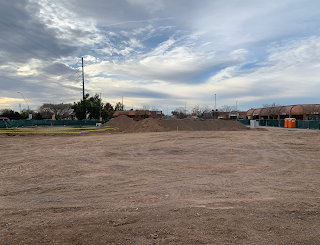How the Phoenix desert was transformed by cash crops
I was watching a documentary yesterday about how forests in Borneo are being cleared away to make way for "cash crops", with the disastrous effects on wildlife, the environment, and ultimately people, who suffer from flooding caused by the land eroding away, because of the lack of forests. And I saw a rescue of an orangutan and her baby, who had been trapped in an area that was too small for them, surrounded by row after row of "cash crop" plants, acre after acre. And since I'm interesting Phoenix history, I started thinking about the transition of the desert here in the Salt River Valley into "cash crops".
Most of the older people that I know remember the endless rows of citrus trees, or cotton that stretched on for miles and miles in the Phoenix area. And of course none of these people are old enough to remember what the area was like before it was converted to cash crops. It's as if Phoenix had always been that way. And it strikes me as how people may remember Borneo generations in the future, just row after row of cash crops, with no memory of the forest. Once something fades out of memory, it's as if it never existed, and the forests and orangutans will be forgotten.
If you're saying, well, the Phoenix are was just a desert anyway, I understand. And personally I like the transformation that people made here in the valley, starting in 1868, with the first canal dug by the Swilling Company. Water from irrigation brought in not only cash crops, but trees for shade, and I like trees. Come to think of it, I like oranges, too. I'm just saying that the Phoenix area wasn't always like that, it was once virgin desert.
 |
| The Saguaro National Park, near Tucson, Arizona. In my mind's eye I can see this as the foothills of Camelback Mountain, before everything was cleared away, and forgotten. |
You don't need a time machine to see what Phoenix was like before just about every trace of what the area had looked like was cleared away. I recommend visiting the Saguaro National Park, which is near Tucson. I'd never seen anything like that until just a couple of years ago, and to me it was breathtaking. I had never seen so many saguaros, and of course everything else that the Phoenix area had before the desert was erased for agriculture. The Tucson area is a little bit lusher than the Salt River Valley, but that protected area is as close as I've seen to what the desert looked like in the Phoenix area before 1868. No one really knows, but it sure wasn't row after row of "cash crops".
Now don't get me wrong, I like living in Phoenix, with water, food, and air conditioning. If where I am right now looked exactly like it did before the pioneers of Phoenix started clearing away the desert, I'd be out in the blazing sun, with maybe a saguaro for shade. But in my imagination I like to picture it. And while it's gone from modern memory, you can still see it, in photos, and in real life, before the age of cash crops.
Image at the top of this post: the foothills of Camelback Mountain in the 1950s. Not a trace of the desert remained, just row after row of cash crops.
If you liked this article, and would like to see more, please consider subscribing to history adventuring on Patreon. If you're already a subscriber, thank you! You make this happen!
Click here to become a Patron!
History adventuring posts are shared there daily. The basic tier is a dollar a month, and the PhD tier, which includes "then and now" photos, billboards, aerials, videos, and super high-definition photos, is five dollars a month, and is discounted for seniors, veterans, and students.




Comments
Post a Comment